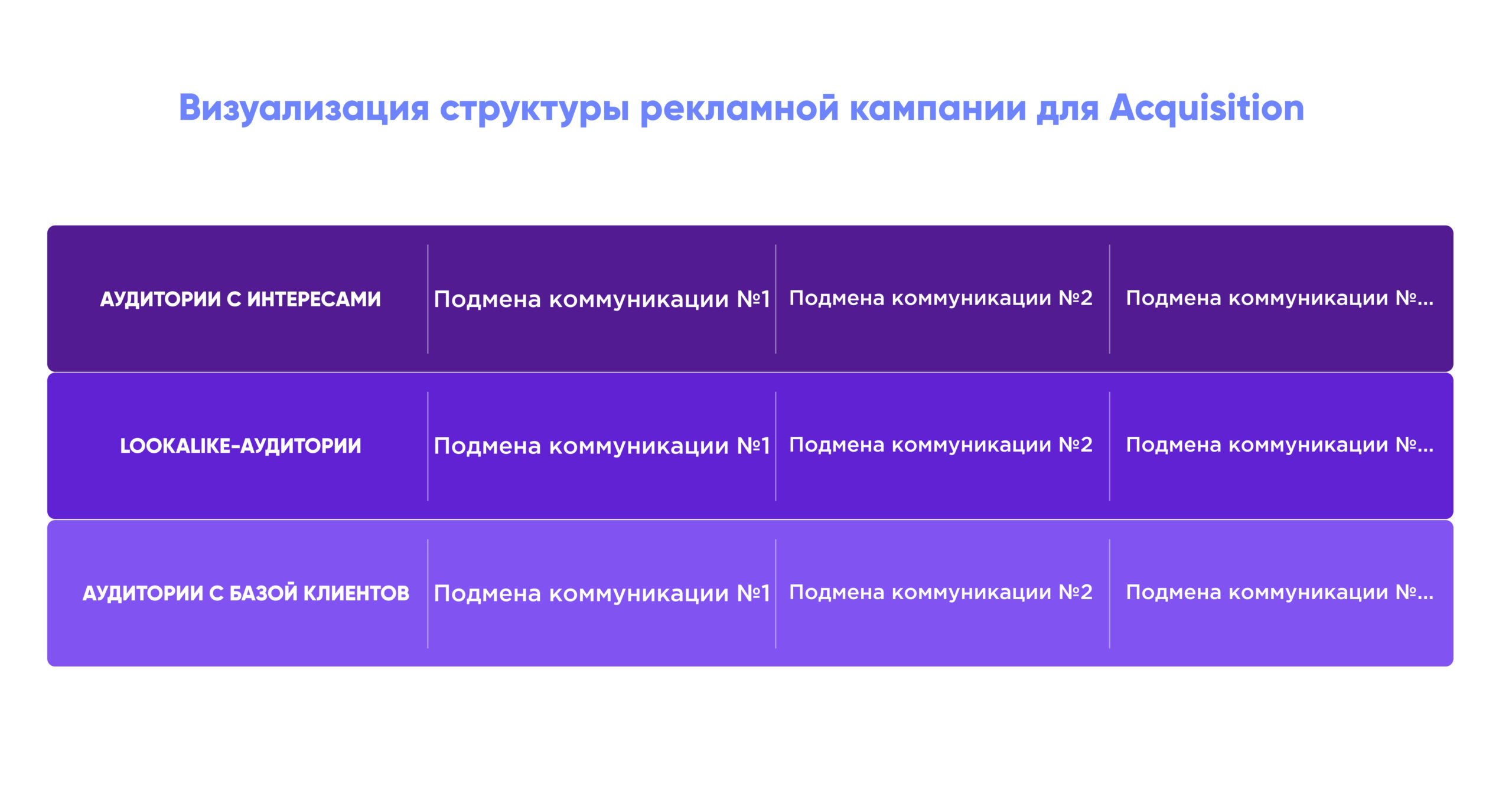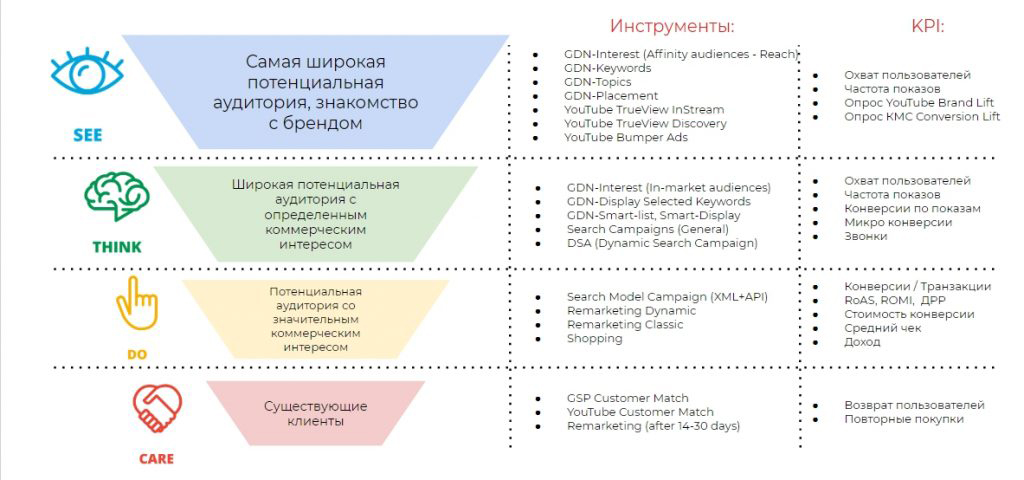Content
In August 2019, we helped a client to set up an advertising campaign, and then in December 2020, they came back to us for more results.
In this case study, we share:
- our experience promoting info-business in Western markets;
- skills for launching multiple educational products simultaneously, both online and offline;
- challenges and difficulties we faced along the way.
About the project
Gerchik.ru prepares future ‘Wall Street wolves’ under the personal guidance of Alexander Gerchik. The company planned a series of events – live seminars and paid online programs. The company had planned a bunch of events — live meetings and paid online programs — and we helped them fill the venues with eager attendees and enroll the right number of students.
Promoting on Facebook
Working on the Project
We began working on the project by auditing the client’s existing campaigns. The client had set up one type of purchase and one type of lead for all products (free and paid) in Ads Manager, which were optimized for the same objectives. Consequently, the Facebook system was unable to collect relevant data — and when creating Lookalike audiences based on the “Purchase” event, the optimization was worse. And when campaigns were launched with the “Website Purchases” objective for free products, the optimization was the same as for paid products, and there were few leads, i.e. the campaigns were not effective.
The project targeted a broad audience with broad interests, such as age targeting people aged 25-65.
After discovering these flaws in the setup we recommended the following:
- Change the objectives to events and carefully consider the stages of the sales funnel to properly associate events with them. To better optimize the ads, we ran several campaigns and changed creatives after each launch. This helped to divide the audience by affordability, and the level of knowledge, and show them relevant and appropriate events accordingly.
- Split the target audience into target groups, and for each group, develop communication strategies with replacements depending on the stage of the funnel.
As a result, it became easier to create targeted messages, which, in turn, increased the relevance of the creative and improved the CTR and lead cost.
The most important aspects of launching an advertising campaign are the audit and strategy preparation, which always take up a significant amount of time. After working through this part, we moved on to the ad settings.
Acquisition (Conversion Objective)
To attract new users, we created three ad groups: one targeted by interests (trading), one with a Lookalike audience, and one that utilized our existing customer base. All groups used the same creatives and communication was changed simultaneously. The most effective group was the “Customer Base” group, but it quickly became exhausted, so in the future, interest-based targeting proved to be the most successful. The initial percentage of matching to the source segment was 2%, and it increased as the frequency grew.
The structure of the user acquisition campaign was as follows:
- Early sales. The early bird ticket sales format took place during the first week.
- Event program. This format lasted the longest out of all the other stages (almost until the end).
- Communication with the message “Limited time until the event starts” (7, 3, 2, 1 day).

During the campaign, we created various types of ads, such as personalized video invitations from Alexander Gerchik, carousels featuring a consistent graphic style and messaging, and banners.
The most effective creative formats were dynamic ads with trading symbols and recognizable charts.
Retargeting
For online webinars, we decided to use retargeting based on our experience that the decision to participate in such an event is made quickly.
For offline events, we used automated funnels with changing messaging broken down into stages of five days each using such messages:
- Why it’s important to attend the seminar.
- The benefits that the attendee will receive.
- The limited time left until the start of the event.
The retargeting funnel was longer with greater variation in messaging. Ads were shown to two groups of users:
- Those who visited the website but did not register for the event.
- Those who registered for the event but did not confirm their contact details.
The user retention campaign was structured as follows:
- Event program.
- Invitation from the instructor Alexander Gerchik (video ads).
- Testimonials from satisfied customers (attendees of previous events).
- Messaging reminding users of the event start time (7, 3, 2, and 1 day(s) before).
Campaign Specifics
Our goal was to generate a certain number of leads at a specific cost per lead to fuel the sales department’s future work. However, the number of leads was directly linked to the budget: increasing the number of leads resulted in a higher cost per lead, which caused the campaign to fall outside of the KPI.
We encountered rapid audience burnout due to the limited number of users with the required interest. To stay within our established KPI, we frequently changed creatives and relaunched campaigns.
Regarding placement, there was no significant difference in ad effectiveness between Facebook and Instagram. The metrics for both platforms were practically identical.
In terms of messaging, emotional messages worked well in acquisition campaigns, while rational messages were effective in retargeting. Overall, ads highlighting new perspectives – what the user would gain after attending the event – were successful.
Promotion on Google
Initial Data
Before launching the advertising campaign on Google, the client had prepared a See-Think-Do-Care model strategy. This strategy targets potential customers at different stages of the buying process, covering all customer categories including those who have stumbled upon or visited the educational center’s page for the first time, as well as those who frequently use the online platform.
Since the client offered a range of products, both paid and free, we allocated where and with which products to display advertising throughout the model.

Fig.2. See-Think-Do-Care Model
Advertising campaigns (AC) that were launched on Google Ads:
- Search AC with general keywords.
- Brand AC directed at the teacher’s personal brand.
- Advertising in the contextual-media network was launched on:
- general words related to commerce;
- terminology related to commerce;
- stock tickers are included as keywords, allowing users to search for relevant information and forecasts on the site.
- Remarketing.
- YouTube campaigns were launched on:
- audiences by interests;
- custom audiences;
- remarketing audiences (users who interacted with the site);
- a selection of channels.
- Discovery campaigns.
- Dynamic search ads.
Implementation
We found that campaigns with general keywords performed the worst in our search campaigns. Therefore, we decided to disable them and instead switched to a more cost-effective and accessible product that we had prepared specifically for this purpose. The new product proved to be more effective in reaching our target audience.

Fig.3. Search campaigns
In our brand campaigns, we faced fierce competition, with competitors targeting our clients as well as companies offering brokerage services.
To select our channels, we used Dmitry Tonkikh’s original script for working with YouTube channels. We were able to collect three channels that we launched as a separate targeting approach.
Discovery campaigns proved to be an effective way to reach customers who were returning to the content they had previously enjoyed via Google services. Although they were launched later than the other campaigns, they worked well for the information business sphere.

Fig.4. Discovery campaigns

Fig. 5. Contextual Media Network Campaigns

Fig.6. All ad campaigns
Audiences for retargeting:
- People who visited specific pages of the website:
- viewed specific lessons on the lead magnet page;
- visited the main product page;
- regularly read articles;
- regularly watch free video materials.
- People who interacted with the client’s YouTube channel:
- recently subscribed;
- subscribers;
- regularly watch video materials.
Remarketing video campaigns had the lowest cost per conversion. The audiences that read content and watched video materials performed well. It was decided to turn off campaigns with ineffective audiences, specifically those who visited the lead magnet page but did not fill out a request form.
Later, we leveraged the client’s CRM system by extracting contacts and uploading them to Google Ads audiences, which enabled us to create additional targeting options using customer lists (Customer Match).
The new audience was segmented into those who:
- left a request for a free product but did not make any purchases before;
- bought something other than the main product;
- bought the main product.
The audience that requested a free product and didn’t purchase anything else performed well, and we continue to successfully work with them. However, the audience that purchased something other than the main product yielded the best results. During the New Year holidays, this audience responded well to promotional offers, and a Lookalike audience was created based on their behavior.
Moreover, we launched dynamic search ads with branded keywords on Google and Yandex. This campaign aimed to redirect queries such as “How to learn to trade on the stock exchange?” to relevant articles on the client’s website. Our ads were designed to look like articles, with clear calls to action to click through. These campaigns generated a large volume of high-quality leads and requests at a low cost. Unfortunately, we were unable to scale or target them to specific users.
To evaluate the effectiveness of our advertising campaigns, we compare data from our advertising account to that of our CRM system using UTM tags. This enables us to determine the actual cost of unique requests.
Conclusions
We set up the campaigns from August 2019 to February 2020 and then handed them over to the client for further in-house work. Although we succeeded in our task, we want to give a recommendation to those who recognize their business in this case. Specifically, if you have many products and offerings, do not launch advertising for all of them simultaneously. This is especially relevant if you have a narrow audience and a specialized product. Plan your marketing activities taking into account the work of a PPC specialist. Consider the network audience size and its Stickiness — the degree of audience loyalty and engagement (evaluating how often users return to the application).
Also, make sure that the events in Facebook Pixel are identical to the funnel. And last but not least, it’s the sales department’s job that closes deals, while targeted advertising only finds and brings the right people to you.
Regarding promotion on Google, using the CRM system’s client base for remarketing purposes, which should be segmented, works best for information businesses. If you have a YouTube channel, you need to link it to your Google Ads account to show ads based on user interaction with videos, thus obtaining additional data in the cabinet and creating remarketing audiences.
Therefore, before launching the project, it’s necessary to study the target audience: find out which sites they visit and write down the keywords that appear on these sites. That’s how we found stock tickers, which is strictly a trading topic. It’s especially important to look for such insights in the audience if the client offers an expensive product.
Thus, when promoting on Facebook and Google in such complex niches as information businesses, it’s essential to use an approach that understands the target audience. A particularly important moment is the elaboration of a strategy, which is a time-consuming process but, if done correctly, will make the advertising campaign efficient after the first launches.
If you have found a spelling error, please, notify us by selecting that text and pressing Ctrl+Enter.











